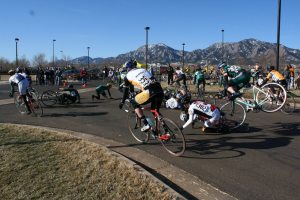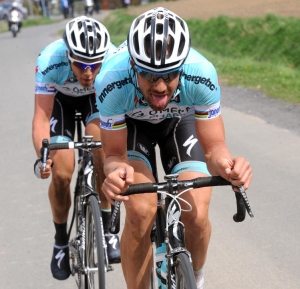There are times when you'll find yourself in unfamiliar company, either on a group ride, a charity ride, a fondo or a race. You'll be surrounded by people you don't know, you're not familiar with their handling skills and you're not even sure if they are comfortable riding in a group. In situations like these, you'll need to be on high alert and ready to defend your space and yourself. Let's face it: if you're stable, sure afoot (awheel?) and not afraid of contact while you're riding, you're actually pretty hard to knock over and crash out. If you're nervous, twitchy and afraid of contact (I.E. you panic and steer away from the guy bumping you) then you're going down sometime sooner rather than later.
Protect Yourself By Protecting Your Bars
Defending yourself includes the space immediately around you and especially around your handlebars. Your bars are your lifeline to your bike: if someone knocks them or takes them out, you lose complete control of your machine and are significantly more prone to crashing. If you're always defending your handlebars, you'll be a lot safer, you'll be a lot more stable and steady, a lot more confident and you'll be a lot less prone to going down.
In order to defend your space and your handlebars, follow these simple tips (and practice them regularly with your regular group ride buddies and teammates):
 Stay low over the bike – Staying low over the bike will lower your center of gravity. Think about descending in the drops or on the hoods: you feel more stable in the drops, right? That's because your center of gravity is moved closer to the ground, making you more stable overall. This is why we ride low on the bike on descents. It's also why we ride low on the bike in a pack: we're harder to knock over. If you're up riding on the tops like you're riding a cruiser, the slightest bump will send your high center of gravity self reeling to the pavement.
Stay low over the bike – Staying low over the bike will lower your center of gravity. Think about descending in the drops or on the hoods: you feel more stable in the drops, right? That's because your center of gravity is moved closer to the ground, making you more stable overall. This is why we ride low on the bike on descents. It's also why we ride low on the bike in a pack: we're harder to knock over. If you're up riding on the tops like you're riding a cruiser, the slightest bump will send your high center of gravity self reeling to the pavement.- Protect your drops – Either keep your hands on the hoods with your forearms parallel to the ground and ready to fend off anyone getting close (this position is often called “Going Belgian” for the habit of one Tom Boonen to grab the hoods with his last two fingers, drop his elbows down into a tight tuck and turning up the gas) or, alternatively, you can have your hands in the drops with your elbows tucked in to your side or slightly flared. Both positions help keep your body low over the bike and protects your hooks. As an extra precaution, having your elbows flared or tucked in by your drops prevents someone from riding up to you and hooking a shifter into your drop, which will almost inevitably cause you to go down and you'll lose some skin.
 Be predictable – You have the power to crash yourself just as much as someone else does. For this reason, and for the reason that you don't want to get tangled up with someone else and go down (or make them go down), it's absolutely imperative that you be comfortable and predictable riding amongst other bodies. You need to understand the implications of each move you make, each drift to the left or right, each move up or down the field you make. You need to avoid making sudden moves, master the art of looking under your arm before you make moves to the sides (to check who's in your “blind spot”) and have some awareness of who's around your space. Never make sudden moves, never grab the brakes without damn good cause to do so. If you're not comfortable riding in a group like this, take a few buddies to an open field, have them ride closer and closer to you on either side to get used to moving within a peloton.
Be predictable – You have the power to crash yourself just as much as someone else does. For this reason, and for the reason that you don't want to get tangled up with someone else and go down (or make them go down), it's absolutely imperative that you be comfortable and predictable riding amongst other bodies. You need to understand the implications of each move you make, each drift to the left or right, each move up or down the field you make. You need to avoid making sudden moves, master the art of looking under your arm before you make moves to the sides (to check who's in your “blind spot”) and have some awareness of who's around your space. Never make sudden moves, never grab the brakes without damn good cause to do so. If you're not comfortable riding in a group like this, take a few buddies to an open field, have them ride closer and closer to you on either side to get used to moving within a peloton.- Stay near the front – The front of the race typically has fewer riders in it, it's typically less twitchy (because people are not fighting to move up through the field) and there are more avenues for escape. There's also a lot less “accordion effect” where any small change in speed at the front becomes a huge change in speed by the time it filters through to the back of the field. Finally, the strongest riders will be at the front, and the stronger riders typically aren't riding on the ragged edge of their fitness or skills to stay up front.
- Don't grab the brakes unnecessarily – It has to be said again, DON'T grab the brakes unless you have a really good reason (like someone just crashed in front of you…)
- Watch the field for unpredictable riders (and stay away from them) – If you see someone do something stupid, dangerous or sketchy at some point in the race, chances are they'll do it again a little later. Check out the video above for a couple good examples of sketchy behavior that should raise a red flag and alert you to someone who is probably a danger in the peloton. Get away from them as quickly as you can.
- Be comfortable making contact (and staying upright) – If you're riding low and elbows out, it'll take a lot for someone else to knock you down, because your bars are protected from contact and your center of gravity is low. You can knock yourself down very easily by being twitchy and tense though. Be comfortable bumping a rider next to you, pushing off them or having them bump into you. If you need practice, get a couple friends, head to a park or football field and ride in the grass while you lean on each other or elbow each other. You'll quickly learn how to push back against them and stay upright. This includes the ability to reach out and put a hand on someone's hip to tell them “hey, I'm in this space.”
- Be comfortable turning your wheel into someone else's – If someone runs across your front wheel and makes contact, the worst thing you can do is to steer sway suddenly. Your wheel will dig into the pavement and fling you to the ground. If your front wheel contacts someone's rear wheel, steer INTO that rear wheel and lay off the gas until it moves away from you. By turning into their rear wheel, you'll keep yourself upright (and they probably won't even know you were there.)
- Stay loose and relaxed – A tight, white-knuckle grip on the bars translates to a twitchy bike handler. Stay loose through the shoulders, neck and arms, and let your elbows bend a little bit. To practice (and illustrate) the difference, find a dry stretch of flat to slightly uphill road and ride along the white line. Try tensing all the muscles in your arms and upper body as if you're nervous (and see how hard it is to stay on the line.) Do the same while staying loose and note how easily you can make small corrections without flying off course. Staying loose can save you more times than you would think.
So there you have it. Keep these tips in mind during group rides and PRACTICE them with your riding buddies or team mates. They should be second nature when you need to deploy them in a group, race or fondo situation. Trust me, everyone around you will thank you for being a solid, safe bike handler.
If you've experienced the “unsafe guy” in a group ride or race, let me know in the comments below.